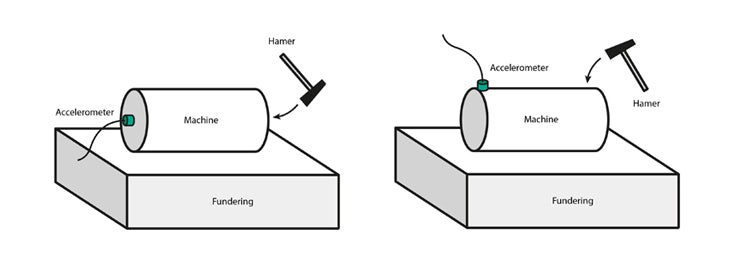When a rotating machine reaches its resonant frequency, it can lead to severe damage to the machine (and the plant), injury to employees, and massive financial consequences. This must be prevented at all costs. Although most rotating machines are designed so that the resonant frequency never coincides with the machine’s speed, resonance can still occur due to design flaws, changes in speed, or external influences (such as the natural frequency of the foundation).
Critical frequencies
Every machine (setup) has one or more natural frequencies; the frequency at which a system tends to vibrate without any driving or damping force present. When a rotating machine is operational, a certain vibration frequency is produced. When this vibration frequency coincides with the natural frequency of the machine (structure), mechanical resonance occurs. In this case, the machine vibrates strongly in tune with the vibration source, producing an amplified vibration. The amplified vibrations can be so strong that they have a destructive effect on the machine.
The causes of vibrations in rotating machines can vary. Learn more in the causes of vibrations.
Solution
It is clear that resonance must be avoided. For this, accelerometers can be used to monitor machine vibration. Using a transmitter, the accelerometer can communicate with a PLC, DCS, or SCADA system, allowing for quick and appropriate action when necessary. It is important to know the critical (resonant) frequencies, as these are used to set alarm values. These alarm values are meant to prevent a rotating machine from reaching the resonant frequency.
More information about accelerometers and their use can be found on the following pages:
- Preventing machine damage with a vibration monitoring system
- Vibration measurements with accelerometers
- 11 tips for choosing the right industrial IEPE accelerometer
- Accelerometers (products)
Methods for determining the resonant frequency
There are several methods for determining the resonant frequency of a machine. The most commonly used methods are discussed below.
Bump test (impact test)
A bump test helps to find the critical frequency(s) of machines. There are different methods for performing a bump test. It can be as simple as giving the material (the machine) a bump with a rubber hammer. Equipment can then take a sample of a few seconds (time domain plot), the period of one rotation of a rotating machine. The sample duration depends on the determined resonance frequencies. It’s important to test the machine at multiple locations; measurements should be taken at both the drive point and the transfer point to determine the resonant frequency of the machine. For this test, the machine must be out of operation to avoid incorrect data and to make it easier to determine the natural frequency of the machine.
Run up/ coast down test
In the so-called “coast down peak hold,” the vibration is monitored from the point where the machine is operational to the shutdown. Without resonance, the vibration level is expected to remain constant. If the vibration level increases during shutdown, the speed at which the amplitude increases may indicate the natural frequency. In addition to this test, there is the more comprehensive “coast down peak phase,” where both the vibration level and the machine’s phase shift are measured. This way, the natural (resonant) frequency can be identified, which lies in the middle of the 180-degree phase shift.
Formula for natural frequency
A third method is to simply calculate the natural frequency using a formula. However, this is not as simple as the formula may suggest. To calculate the natural frequency (ωn) of a machine, the parameters stiffness (k) and mass (m) must be known. This is often not the case. In particular, determining the stiffness of a structure is very difficult. Furthermore, the natural frequency changes when one of the two parameters changes. Therefore, this method is rarely used.
Changing the natural frequency
The natural frequency can be changed by, for example, changing the stiffness or mass of the machine. By increasing the mass or decreasing the stiffness, the natural frequency will decrease. Conversely, a decrease in mass and an increase in stiffness will increase the natural frequency.
It is not always possible to change one of the parameters (stiffness or mass). In this case, the speed at which the machine rotates can be changed. However, this is often not an option; a machine rotates at a certain speed for a reason. There is also the option to place a dynamic shock absorber on the machine, which serves to significantly reduce the vibration levels.
As one of the most common causes of extraordinary machine vibration, it is important to avoid operating within the resonant frequency. To determine this frequency, precise measurement is necessary to identify the natural frequency. In addition to resonance, imbalance, misalignment, or damaged components often play a major role in causing abnormal vibration behavior.

